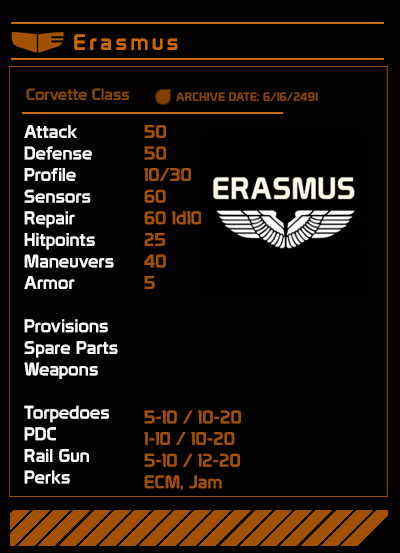The Erasmus
- Stark Osterham
-
 Topic Author
Topic Author
- Offline
- Administrator
-

Less
More
- Posts: 15
- Thank you received: 9
3 years 1 month ago - 3 years 1 month ago #46
by Stark Osterham
Erasmus
Model: Lanza class corvette
Passenger Capacity: 30
Drive Signature: Martian Freighter
Transponder: Martian Military Vessel
Funds: 800c
Hit Points: 25
Profile: 10/30
Sensors: 60 (apply enemy profile modifier)
Maneuvers: 50
Armor 5
Torpedoes 5-10 / 10-20
PDC 1-10 / 10-20
Hardpoints: 6/11
Ship Status
Provisions 30
Spare Parts
Cargo 100
Manufacturer: Vander Air & Space Corporation technology
Engine: LDD-H3 MBI228
Model Number: 4489295s7723205-k7
MCN ID: 42-H7393 22Y
SOL Safety Certificate: 923478-378
Crew
Eve Dimitriaski - (Gunner) 50%
Zero - Engineer ( Repair ) 60%
Eve Dimitriaski M4- Pilot ( Maneuvers ) 40%
Zero - Communications (Sensors) 60%
Total Hit Points: 25
Sub systems D40:
1 - PDC(s)
2 - cockpit
3 - operations
4 - galley
5 - cargo space
6 - crew quarters
7 - missile bay
8 - machine shop
9 - hydroponics
10 - medical bay
11 - armory
12 - airlock
13 - reactor
14 - engines
15 - life support
16 - thrusters
17 - sensors
18 - Communication
19 - ventilation
20 - torpedo tubes
21 - capacitor(s)
22-40 Outer Hull
Erasmus Armament(1k-5k)
3x twin barrel turret 120
2x rear facing cannon 150
2x fore facing cannon 150
Hit Rating: 60/40, dmg: 1-10/ 10-20
2x missile tubes ( 60% good lock, 40% average lock)
Torpedo bay x11
x2 Rear & Fore 150mm VRC-15 Rail Cannons
Unlike the repeating gauss cannons deployed about the ship the VRC-15 is designed for orbital bombardment though with careful planning can be deployed against enemy vessels.
While the damage output is exponential the vessel does need to maintain a regular burn to ensure it does not drift off course due to recoil.
The VRC-15 fires a 150mm 2kg projectile though at present time they're currently offline due to power and maintenance requirements
2x Mid Ranged Missile Tubes
The Erasmus missile tubes, located on the port and starboard sides capable of either releasing or firing variable payload missile from an internal magazine. Hit Rating: 60/40, dmg: 1-250 / 100-400
*Reloading said magazine does require a space walk.
Torpedo bay
The Erasmus carries two long range torpedoes capable of being deployed from a bay located in the lower aft section of the ship.
Said torpedoes are capable of variable warhead configurations in addition capable of planet fall in the event orbital strikes are required.
VGC-12 "Deflector" Repeating Gauss Cannon
Firing 20 mm tungsten slugs the VGC-12 is fully capable of doubling as a point defense weapon thanks to it's rate of fire and aggressive tracking systems. While firing at a slower speed than a traditional gauss cannon the VGC-12 makes up for this with a rate of fire approaching 4500 rpm or 75 rps.
Thanks to the smaller caliber and lower velocity these guns can fire with little to no course correction needed though sustained fire will deplete ammo reserves at an astonishing rate.
Erasmus Sensor systems
The front pylons on the ship contain some of the main sensor functions, projected forward to isolate them from interference by the bulk of the ship. These include a 20m planar radio telescope array and a back up 10m array for passive monitoring of the electromagnetic spectrum. Further back along the forward hull the ship mounts an optical and an infrared telescope, each with a 6 meter aperture.
Active sensors consist of main two radomes fitted with centimeter-wave radar arrays for navigation and deep space scanning. These arrays are capable of detecting a 2 meter square object at 80km and a 100 meter square object at 60,000km. The ship also mounts four smaller centimeter wave arrays, one along each aspect angle, to provide independent targeting data for the weapon systems.
The communications array is a 20m main antenna with a backup 10m antenna mounted with a battery of microwave banks for in-system communications, as well as numerous low band receivers for picking up and monitoring surface frequencies. Due to its mission profiles, the Erasmus often operates in radio silence to reduce its detectable EM emissions. For this it has a full suite of proprietary entangled particle comms as well as a 12kw lidar array for tight beam LOS communication.
For defensive electronics the Erasmus mounts a full electronics warfare suite of ECM/ECCM and ED/ECD. It is capable of signal monitoring and interception across a wide band, facilitating its functions with special warfare units.
Hull
Over the main frame the ship's skin consists of a multi layered fusion of insulators, aerogel thermal dissipation matrix, boron-carbide micrometeorite shielding, and external alloy armor. The ships survivabilty against kinetic kill weapons is further augmented by the addition of modular ablative armor plates positioned over critical areas of the hull and superstructure. These ablative plates are easily replaced in the event of damage and shield the main hull beneath. The aerogel layers assist in thermal masking and are capable of dissipating up to 150 kilograys of radiation from directed energy weapons.
Erasmus Reactor
Leahy Drive
D-H3 fusion pulse reactor created for forward operations. primarily used by mid to long range ships, most notably gunships, due to high burn, high response thrust. Using magneto-inertial fusion(MIF), it can rapidly heat d-H3 to the optimal temperatures, creating plasma that is compressed along an electrified coil of wire acting as a magnet and creating a vacuum chamber that contains the plasma. Mirror magnets at each end of the chamber refocus the plasma, blocking too rapid release. This creates an impulse that can reach .1% speed of light. Once optimal thrust has been reached, the drive goes into neutral stasis, allowing the ship to coast and energy stored in generators that create super heated steam take over. This steam is used for day to day operations as well as minor modifications and course corrections while keeping the reactor at optimal state for any emergencies and to cycle up when approaching destination.
Erynium was the key to unlocking the Leahy Drive's full potential. this mineral, once discovered on Mars, became the protective coating on the interior of the reactor. it provides necessary heat shielding for both the exterior and interior elements. without it, the interior elements, primarily the coils, would rapidly break down under the high temperatures.
VASC gunships have a few special features connected with their Leahy Drives. the Lanza class of ships, including the Erasmus, have a special honeycomb system of eyrnium pipes between interior and exterior hulls. this allows for a rapid dissemination of heat from the reactor in emergency or combat potential situations. If activated, either remotely via Ops or by the Engineer directly, the reactor will go neutral and its heat will be forced through the pipes, being vented through small openings as Infrared Light. This allows the Erasmus to rapidly hide its thermal footprint.
Radiation Shielding
Erasmus has hydrognated boron nitride nanotubes(BNNT) built directly into its framework. These tiny, nanotubes made of carbon, boron, and nitrogen, with hydrogen interspersed throughout. the combination of boron and hydrogen blocks radiation from passing through to the inner hull and impacting the crew. It is also found in the spacesuits commonly used on Mars and during space walks.
Notes
Characters who are not restrained during high-g maneuvers receive damage
Characters who are experiencing excessive G-force must make a endurance-will roll to remain awake. G-force over 7 receive 1D12 points of damage every turn of acceleration.
The Erasmus was created by Stark Osterham
Erasmus
Model: Lanza class corvette
Passenger Capacity: 30
Drive Signature: Martian Freighter
Transponder: Martian Military Vessel
Funds: 800c
Hit Points: 25
Profile: 10/30
Sensors: 60 (apply enemy profile modifier)
Maneuvers: 50
Armor 5
Torpedoes 5-10 / 10-20
PDC 1-10 / 10-20
Hardpoints: 6/11
Ship Status
Provisions 30
Spare Parts
Cargo 100
Manufacturer: Vander Air & Space Corporation technology
Engine: LDD-H3 MBI228
Model Number: 4489295s7723205-k7
MCN ID: 42-H7393 22Y
SOL Safety Certificate: 923478-378
Crew
Eve Dimitriaski - (Gunner) 50%
Zero - Engineer ( Repair ) 60%
Eve Dimitriaski M4- Pilot ( Maneuvers ) 40%
Zero - Communications (Sensors) 60%
Total Hit Points: 25
Sub systems D40:
1 - PDC(s)
2 - cockpit
3 - operations
4 - galley
5 - cargo space
6 - crew quarters
7 - missile bay
8 - machine shop
9 - hydroponics
10 - medical bay
11 - armory
12 - airlock
13 - reactor
14 - engines
15 - life support
16 - thrusters
17 - sensors
18 - Communication
19 - ventilation
20 - torpedo tubes
21 - capacitor(s)
22-40 Outer Hull
Erasmus Armament(1k-5k)
3x twin barrel turret 120
2x rear facing cannon 150
2x fore facing cannon 150
Hit Rating: 60/40, dmg: 1-10/ 10-20
2x missile tubes ( 60% good lock, 40% average lock)
Torpedo bay x11
x2 Rear & Fore 150mm VRC-15 Rail Cannons
Unlike the repeating gauss cannons deployed about the ship the VRC-15 is designed for orbital bombardment though with careful planning can be deployed against enemy vessels.
While the damage output is exponential the vessel does need to maintain a regular burn to ensure it does not drift off course due to recoil.
The VRC-15 fires a 150mm 2kg projectile though at present time they're currently offline due to power and maintenance requirements
2x Mid Ranged Missile Tubes
The Erasmus missile tubes, located on the port and starboard sides capable of either releasing or firing variable payload missile from an internal magazine. Hit Rating: 60/40, dmg: 1-250 / 100-400
*Reloading said magazine does require a space walk.
Torpedo bay
The Erasmus carries two long range torpedoes capable of being deployed from a bay located in the lower aft section of the ship.
Said torpedoes are capable of variable warhead configurations in addition capable of planet fall in the event orbital strikes are required.
VGC-12 "Deflector" Repeating Gauss Cannon
Firing 20 mm tungsten slugs the VGC-12 is fully capable of doubling as a point defense weapon thanks to it's rate of fire and aggressive tracking systems. While firing at a slower speed than a traditional gauss cannon the VGC-12 makes up for this with a rate of fire approaching 4500 rpm or 75 rps.
Thanks to the smaller caliber and lower velocity these guns can fire with little to no course correction needed though sustained fire will deplete ammo reserves at an astonishing rate.
Erasmus Sensor systems
The front pylons on the ship contain some of the main sensor functions, projected forward to isolate them from interference by the bulk of the ship. These include a 20m planar radio telescope array and a back up 10m array for passive monitoring of the electromagnetic spectrum. Further back along the forward hull the ship mounts an optical and an infrared telescope, each with a 6 meter aperture.
Active sensors consist of main two radomes fitted with centimeter-wave radar arrays for navigation and deep space scanning. These arrays are capable of detecting a 2 meter square object at 80km and a 100 meter square object at 60,000km. The ship also mounts four smaller centimeter wave arrays, one along each aspect angle, to provide independent targeting data for the weapon systems.
The communications array is a 20m main antenna with a backup 10m antenna mounted with a battery of microwave banks for in-system communications, as well as numerous low band receivers for picking up and monitoring surface frequencies. Due to its mission profiles, the Erasmus often operates in radio silence to reduce its detectable EM emissions. For this it has a full suite of proprietary entangled particle comms as well as a 12kw lidar array for tight beam LOS communication.
For defensive electronics the Erasmus mounts a full electronics warfare suite of ECM/ECCM and ED/ECD. It is capable of signal monitoring and interception across a wide band, facilitating its functions with special warfare units.
Hull
Over the main frame the ship's skin consists of a multi layered fusion of insulators, aerogel thermal dissipation matrix, boron-carbide micrometeorite shielding, and external alloy armor. The ships survivabilty against kinetic kill weapons is further augmented by the addition of modular ablative armor plates positioned over critical areas of the hull and superstructure. These ablative plates are easily replaced in the event of damage and shield the main hull beneath. The aerogel layers assist in thermal masking and are capable of dissipating up to 150 kilograys of radiation from directed energy weapons.
Erasmus Reactor
Leahy Drive
D-H3 fusion pulse reactor created for forward operations. primarily used by mid to long range ships, most notably gunships, due to high burn, high response thrust. Using magneto-inertial fusion(MIF), it can rapidly heat d-H3 to the optimal temperatures, creating plasma that is compressed along an electrified coil of wire acting as a magnet and creating a vacuum chamber that contains the plasma. Mirror magnets at each end of the chamber refocus the plasma, blocking too rapid release. This creates an impulse that can reach .1% speed of light. Once optimal thrust has been reached, the drive goes into neutral stasis, allowing the ship to coast and energy stored in generators that create super heated steam take over. This steam is used for day to day operations as well as minor modifications and course corrections while keeping the reactor at optimal state for any emergencies and to cycle up when approaching destination.
Erynium was the key to unlocking the Leahy Drive's full potential. this mineral, once discovered on Mars, became the protective coating on the interior of the reactor. it provides necessary heat shielding for both the exterior and interior elements. without it, the interior elements, primarily the coils, would rapidly break down under the high temperatures.
VASC gunships have a few special features connected with their Leahy Drives. the Lanza class of ships, including the Erasmus, have a special honeycomb system of eyrnium pipes between interior and exterior hulls. this allows for a rapid dissemination of heat from the reactor in emergency or combat potential situations. If activated, either remotely via Ops or by the Engineer directly, the reactor will go neutral and its heat will be forced through the pipes, being vented through small openings as Infrared Light. This allows the Erasmus to rapidly hide its thermal footprint.
Radiation Shielding
Erasmus has hydrognated boron nitride nanotubes(BNNT) built directly into its framework. These tiny, nanotubes made of carbon, boron, and nitrogen, with hydrogen interspersed throughout. the combination of boron and hydrogen blocks radiation from passing through to the inner hull and impacting the crew. It is also found in the spacesuits commonly used on Mars and during space walks.
Notes
Characters who are not restrained during high-g maneuvers receive damage
Characters who are experiencing excessive G-force must make a endurance-will roll to remain awake. G-force over 7 receive 1D12 points of damage every turn of acceleration.
Last edit: 3 years 1 month ago by Stark Osterham.
The following user(s) said Thank You: Elsie
Please Log in or Create an account to join the conversation.
Time to create page: 0.096 seconds


